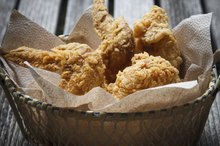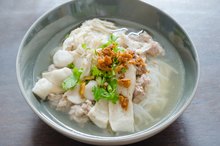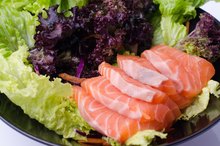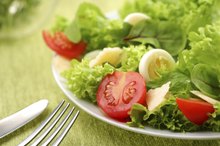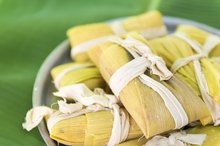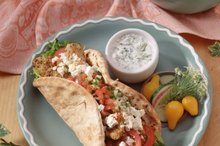Salads With Low Carbs & High Protein
Leafy greens and other vegetables that you may eat in your salads, tossed with a protein source, are naturally low in digestible carbohydrates. Although vegetables and fruits are rich in fiber, your body doesn’t digest this complex carb. When you calculate the carbohydrate content of leafy dark greens, cucumbers, carrots, tomatoes and broccoli using the Academy of Nutrition and Dietetic’s food exchange list, you may realize that generous portions of these nutritious foods won't break your daily carbohydrate budget.
Basic Salad Ingredients
Most leafy greens and nonstarchy salad vegetables are low in calories and carbohydrates. According to the AND food exchange list, 1 cup of romaine lettuce has 8 calories and 2 grams of carbs and 1 cup of raw spinach has 7 calories and 1 gram of carbs. As another example, 1 cup of raw tomato has 32 calories and 7 grams of carbs.
You can make low-carb, high-protein salads using these vegetables and mushrooms, bell peppers, cucumbers or zucchini. Add chicken or turkey, hard-boiled eggs, grilled salmon, nuts, pumpkin or sunflower seeds or low-fat cheese to make nutritious salads that are low in carbs and high in protein. A 3-oounce serving of cooked poultry has 24 grams of protein, one large egg has 6 grams of protein and 1/2 cup of tofu has 10 grams of protein, according to Drugs.com. To keep your salads low in carbs when you’re dining out, omit croutons and crackers, potato or macaroni salads and the big basket of dinner rolls in the middle of the table.
High-Protein Greek Salad
Nutritional Information on Melting Pot Restaurant
Learn More
A Greek salad includes tomato wedges, cucumber slices, slices of sweet red onion, Kalamata olives and crumbled feta cheese; in the United States it is often served on a bed of lettuce or other leafy greens. This blend of low-carb foods is seasoned with lemon juice, olive oil, oregano and coarse black pepper. For extra protein, add slices of grilled or broiled chicken breast, a sliced hard-boiled egg or crumbled tofu.
Light Summer Lunch
Although fruits have more carbohydrates than nonstarchy vegetables, you can include one serving of fresh melon or berries in your salads without going overboard on carbs. According to the AND, 1/2 cup of cantaloupe has 28 calories and 6.5 grams of carbs and 1/2 cup of raspberries has 30 calories and 7 grams of carbs. Blend 1/2 cup of cubed cantaloupe, honeydew melon or papaya with sliced chicken, chopped celery, a sprinkling of chopped walnuts and 1 cup of romaine lettuce in a creamy, low-fat cucumber dressing for a refreshing summer salad.
Salad on the Go
Hooters Nutritional Guide
Learn More
Some fast-food restaurants offer healthy alternatives to hamburgers and french fries, including nutritious, convenient salads that are low in carbohydrates and high in protein. A 10.9-ounce chicken Caesar salad from McDonald's has 221 calories, about 11 grams of carbohydrates and about 31 grams of protein, according to the U.S. Department of Agriculture.
Burger Without the Bun Salad
With the increasing popularity of low-carb diets, some restaurants are offering creative alternatives to dishes that traditionally include bread, potatoes, or other high-carb foods. A bowl of salad greens, tomatoes, cucumbers, mushrooms, cucumbers, red onions and crumbled blue cheese replaces the bun and fixings in a low-carb hamburger at a New York City restaurant reviewed by The Nibble. You can make your own version of this “bunless burger” at home by topping a large portion of your favorite green salad with a lean ground beef or turkey patty. A 3-ounce portion of cooked beef has 21 grams of protein; the same serving of cooked turkey has 24 grams of protein.
Related Articles
References
Writer Bio
Anne Tourney specializes in health and nutrition topics. She is a registered nurse with experience in medical-surgical nursing, behavioral health and geriatrics. Tourney earned a Bachelor of Science in nursing from Regis University.

